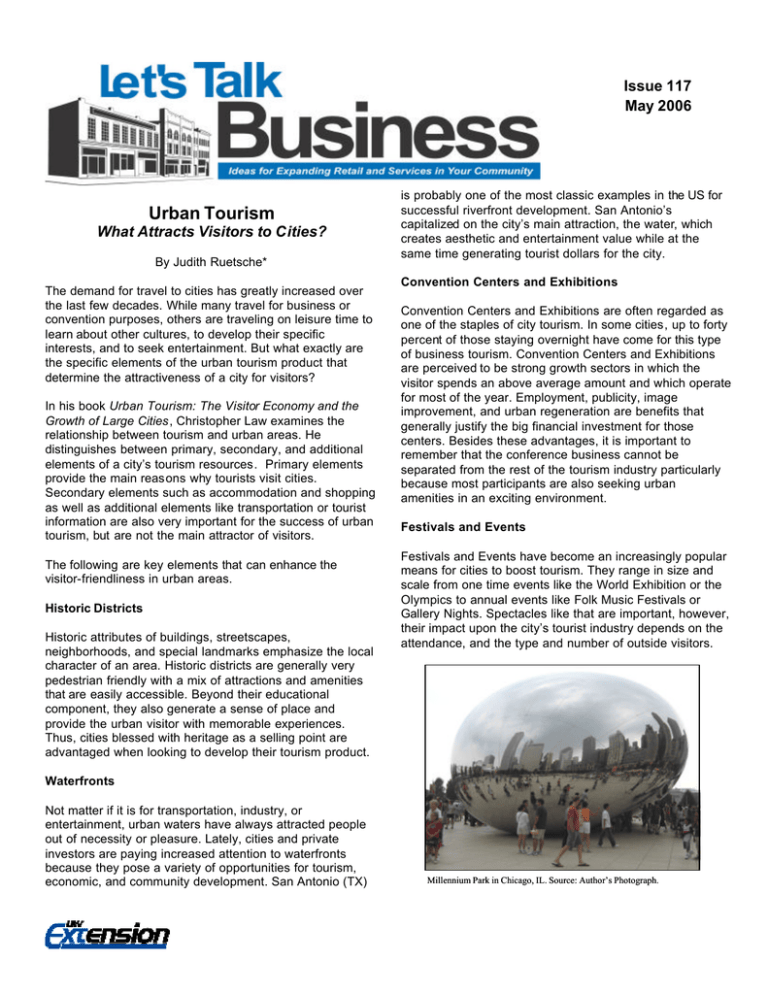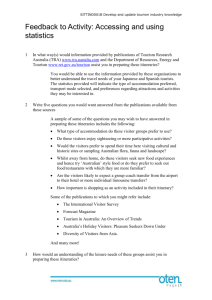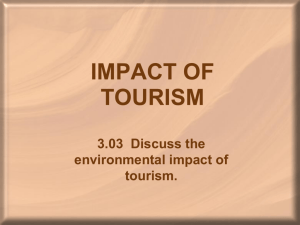Issue 117 May 2006
advertisement

Issue 117 May 2006 Urban Tourism What Attracts Visitors to Cities? By Judith Ruetsche* The demand for travel to cities has greatly increased over the last few decades. While many travel for business or convention purposes, others are traveling on leisure time to learn about other cultures, to develop their specific interests, and to seek entertainment. But what exactly are the specific elements of the urban tourism product that determine the attractiveness of a city for visitors? In his book Urban Tourism: The Visitor Economy and the Growth of Large Cities, Christopher Law examines the relationship between tourism and urban areas. He distinguishes between primary, secondary, and additional elements of a city’s tourism resources. Primary elements provide the main reasons why tourists visit cities. Secondary elements such as accommodation and shopping as well as additional elements like transportation or tourist information are also very important for the success of urban tourism, but are not the main attractor of visitors. The following are key elements that can enhance the visitor-friendliness in urban areas. Historic Districts Historic attributes of buildings, streetscapes, neighborhoods, and special landmarks emphasize the local character of an area. Historic districts are generally very pedestrian friendly with a mix of attractions and amenities that are easily accessible. Beyond their educational component, they also generate a sense of place and provide the urban visitor with memorable experiences. Thus, cities blessed with heritage as a selling point are advantaged when looking to develop their tourism product. is probably one of the most classic examples in the US for successful riverfront development. San Antonio’s capitalized on the city’s main attraction, the water, which creates aesthetic and entertainment value while at the same time generating tourist dollars for the city. Convention Centers and Exhibitions Convention Centers and Exhibitions are often regarded as one of the staples of city tourism. In some cities, up to forty percent of those staying overnight have come for this type of business tourism. Convention Centers and Exhibitions are perceived to be strong growth sectors in which the visitor spends an above average amount and which operate for most of the year. Employment, publicity, image improvement, and urban regeneration are benefits that generally justify the big financial investment for those centers. Besides these advantages, it is important to remember that the conference business cannot be separated from the rest of the tourism industry particularly because most participants are also seeking urban amenities in an exciting environment. Festivals and Events Festivals and Events have become an increasingly popular means for cities to boost tourism. They range in size and scale from one time events like the World Exhibition or the Olympics to annual events like Folk Music Festivals or Gallery Nights. Spectacles like that are important, however, their impact upon the city’s tourist industry depends on the attendance, and the type and number of outside visitors. Waterfronts Not matter if it is for transportation, industry, or entertainment, urban waters have always attracted people out of necessity or pleasure. Lately, cities and private investors are paying increased attention to waterfronts because they pose a variety of opportunities for tourism, economic, and community development. San Antonio (TX) Millennium Park in Chicago, IL. Source: Author’s Photograph. PRIMARY ELEMENTS Activity Place Cultural Facilities Leisure Setting Physical Characteristics • Museums and Art Galleries • Historical Street Pattern • Theaters and Cinemas • Interesting Buildings • Concert Halls • Ancients Monuments and Statues • Convention Centers • Parks and Green Areas • Other Visitor Attractions • Waterfronts (Harbor, Canal, River) Sport Facilities Socio-Cultural Features • Indoor and Outdoor • Liveliness of the Place Amusement Facilities • Language • Night Clubs • Local Customs and Costumes • Casinos and Bingo Halls • Cultural Heritage • Organized Events • Friendliness • Festivals • Security SECONDARY ELEMENTS ADDITIONAL ELEMENTS • Accommodation • Accessibility • Catering Facilities • Transportation and Parking • Shopping • Tourist Information (maps, signs, guides) • Markets Special Visitor Districts Special visitor districts are places where a combination of visitor attractions such as cultural, amusements, or sports facilities are clustered in one location. These districts are not merely a strategy to attract tourists and provide better amenities for local residents, but one that can be used to facilitate urban renewal. Special visitor districts enable visitors to move easily from one attraction to another, and, if this is known in advance, may encourage more visitors to come to the city due to a critical mass of attractions). In many parts of the world, special visitor districts have been the anchor for regenerated dockland zones. In Baltimore, for instance, the Inner Harbor was planned with three such attractions: an aquarium, a science museum and a viewing platform at the top of the World Tr ade Center. According to the Baltimore Area Convention and Visitors Association, the total number of out-of-town visitors was almost 12 million. These guests spent an estimated $2.9 billion. Tourism Employees and Residents as City Advocates friendliness. Key factors in visitor’s decision to visit a place are friendly, hospitable people. That’s what people remember and that’s what they come back for. Responsibility for the “Welcome”, however, does not rest solely with tourism employees. Each and every person working and living in the city, who has contact with visitors, should market themselves to the kind of visitors needed to bring more dollars to restaurants, hotels, museum and other entertaining places. If urban tourism wants to continue to grow and prosper, everyone, from the cab driver to the storeowner and the resident, should act as a tourism agent and provide their guests with positive memorable experiences. Retail and Catering Facilities Although shopping and restaurants are regarded as a secondary element of tourism, it is still an important part of the tourism economy since visitors spend a significant amount of time and money on shopping and eating. Shopping, for instance, has for some visitors become a leisure activity where they tour stores with no specific purpose in mind. For others, it is more like a sport where they go from store to store and see if there are different goods on sale at the destination compared to home. Cities that add retail stores or restaurants to their downtown or to special facilities like airports, train stations, or casinos, experience positive economic impacts that not only apply to one location, but spill over and trickle down to other areas of the city. Conclusion For clarity, the tourism elements presented in this article have been largely treated separately; however, it is important to point out that there is a high degree of interrelatedness among the elements. They are being developed by cities for a variety of reasons including portraying a positive image, attracting visitors, and stimulating the urban economy. Source: Law, Christopher. 2002. Urban Tourism: The Visitor Economy and the Growth of Large Cities. London: Continuum. 2006 Baltimore Area Convention and Visitors Association (BACVA): http://www.baltimore.org/media/media_pr_092205.html *Judith Ruetsche is a graduate student in Urban and Regional Planning at the University of Wisconsin-Madison. Friendliness is probably one of the most important sociocultural features of the tourism product. Professionalism and excellence of service offered to visitors start with Contact: Bill Ryan, Center For Community & Economic Development, University of Wisconsin-Extension, 610 Langdon Street, Madison, WI 53703-1104 PH: (608)265-8136; FAX: (608)263-4999; TTY: (800)947-3529; http://www.uwex.edu/ces/cced This article may be reprinted and redistributed for educational purposes by crediting “University of Wisconsin-Extension, Let’s Talk Business eNewsletter.” An EEO/Affirmative Action Employer, UW-Extension provides equal opportunities in employment and programming, including Title IX and ADA requirements.





